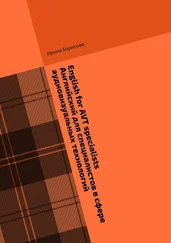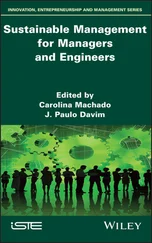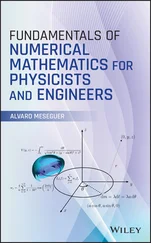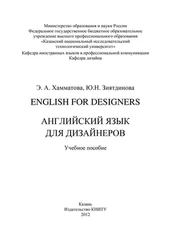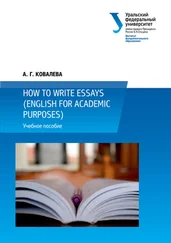Т.Ю.Кущ, М.С.ВоловникАнглийский язык для судовых электромехаников. ENGLISH FOR MARINE ELECTRICAL ENGINEERS. 1986
Здесь есть возможность читать онлайн «Т.Ю.Кущ, М.С.ВоловникАнглийский язык для судовых электромехаников. ENGLISH FOR MARINE ELECTRICAL ENGINEERS. 1986» весь текст электронной книги совершенно бесплатно (целиком полную версию без сокращений). В некоторых случаях можно слушать аудио, скачать через торрент в формате fb2 и присутствует краткое содержание. Жанр: Прочая научная литература, на английском языке. Описание произведения, (предисловие) а так же отзывы посетителей доступны на портале библиотеки ЛибКат.
- Название:Т.Ю.Кущ, М.С.ВоловникАнглийский язык для судовых электромехаников. ENGLISH FOR MARINE ELECTRICAL ENGINEERS. 1986
- Автор:
- Жанр:
- Год:неизвестен
- ISBN:нет данных
- Рейтинг книги:5 / 5. Голосов: 1
-
Избранное:Добавить в избранное
- Отзывы:
-
Ваша оценка:
- 100
- 1
- 2
- 3
- 4
- 5
Т.Ю.Кущ, М.С.ВоловникАнглийский язык для судовых электромехаников. ENGLISH FOR MARINE ELECTRICAL ENGINEERS. 1986: краткое содержание, описание и аннотация
Предлагаем к чтению аннотацию, описание, краткое содержание или предисловие (зависит от того, что написал сам автор книги «Т.Ю.Кущ, М.С.ВоловникАнглийский язык для судовых электромехаников. ENGLISH FOR MARINE ELECTRICAL ENGINEERS. 1986»). Если вы не нашли необходимую информацию о книге — напишите в комментариях, мы постараемся отыскать её.
Т.Ю.Кущ, М.С.ВоловникАнглийский язык для судовых электромехаников. ENGLISH FOR MARINE ELECTRICAL ENGINEERS. 1986 — читать онлайн бесплатно полную книгу (весь текст) целиком
Ниже представлен текст книги, разбитый по страницам. Система сохранения места последней прочитанной страницы, позволяет с удобством читать онлайн бесплатно книгу «Т.Ю.Кущ, М.С.ВоловникАнглийский язык для судовых электромехаников. ENGLISH FOR MARINE ELECTRICAL ENGINEERS. 1986», без необходимости каждый раз заново искать на чём Вы остановились. Поставьте закладку, и сможете в любой момент перейти на страницу, на которой закончили чтение.
Интервал:
Закладка:
Hometask'. Ex. 10, 15, 21.
The third class period
22 3
Listen to the sentences and define in each of them the meaning of the word “common”.
1. In common with other students he had little time. 2. The British Parliament has two Houses: the House of Commons and the House of Lords. 3. These motors have nothing in common. 4. How do you like this meter? —Well, it’s nothing out of the common. 5. Your idea is something out of the common.
23 4
Listen carefully to the tape-recorded text and render it in English.
The wattmeter conventionally a 60-cycle power meter is not frequently used in the modern electronic laboratory. This is because phase differences are difficult to handle, and because power consumption frequencies have a different significance and are usually not measured by direct-reading meters,
Briefly, in 60-cycle measurements the wattmeter has a dynamometer movement, load current is sent through one coil and load-proportional voltage produces a current which is sent through the other. Phase differences between the two inputs reflect themselves in the repulsive or attractive forces between the coils, and a true reading of power is given by the final deflection.
24 6
Fulfil or explain the following:
1. Name the basic electrical measuring instruments (10).
2. Show a simple drawing of ammeter and voltmeter connections to a circuit.
3. Give some characteristics and applications of the most common a-c meter.
25 5
Record your answers on a tape.
1. What methods are commonly used in electrical service work to determine if the circuits of an equipment are operating properly?
2. When do they use a watt-hour or kilowatt-hour meter?
3. What is most essential in servicing and maintaining electrical equipment?
4. What advantage does a PM moving coil meter have over an iron-vane meter?
26 7
Prepare a) short talk with your fellow-student on basic electrical measuring instruments. Use ex. 24, 25. Then record your dialogue.
27 4
Solve these two problems.
1. Suppose the ammeter scales reads 1.9 amp., the voltmeter scale reads 2.4. V. How much is the value of resistance in the measured circuit?
2. Suppose the ohmmeter scale reads 75 ohms, the voltmeter scale reads 220 V. How much is the value of current in the measured circuit?
28 9
Practice pronunciation. Open your books and repeat after the speaker in pauses 3 paragraphs of the recorded text “Basic Electrical Measuring Instruments”. Thea close your books and do the same with paragraphs 4—7.
29 1
What is the name of this device?
This device measures the frequency of alternating current. It consists of a tuned circuit calibrated in frequencies. It can show maximum current when; the tuned frequency of the circuit is the same as the frequency of the voltage or current being measured.
30 6
After listening to two texts say what differs them and what they have in common.
Capacitors
The capacity of a capacitor is measured in farads. A capacitor has a capacity of 1 farad when a charge of 1 coulomb increases the potential, between its plates, by 1 volt.
The capacity depends on four things: a) the higher the voltage used to charge the capacitor the more energy it will store; b) the larger the size; of plates and the greater their number the more energy will be stored; c) the closer are the positive an.d negative plates the greater is the charge; d) some insulators store greater charge than others.
Capacitor in A-C Line
When a capacitor is connected into a circuit through which alternating current is flowing, the plates of the capacitor are charged negatively or positively.
In order to show the action of a capacitor in an a-c line, connect a capacitor in series with a lamp and plug into the a-c lighting. The lamp will glow provided its resistance does not prevent. Then connect another capacitor in parallel and the lamp will glow brighter. Connecting more capacitors and increasing the capacity we increase the glow.
Thus, capacitors oppose the flow of current.
31 20
Home exercise. Write your recommendations on general requirements to lighting and be prepared to dwell on the subject provided by the text.
Lighting. General Requirements.
In all rooms, spaces and locations' of the ship where lighting is necessary to ensure the safety of navigation, operating of machinery and equipment, as well as accommodating and evacuation of passengers and crew, stationary fixtures 1of main lighting are to be installed.
Lighting fixtures installed in rooms and spaces, where mechanical damage is possible to the glass hoods 2are to be provided with' protecting gratings 3.
Lighting fixtures are to be installed in such a manner as to prevent; heating of cables and adjacent materials up to a temperature exceeding the permissible 4level.
Permanently-installed lighting fixtures in holds are to take their power supply from a special switchboard. Apart from the fuses and switches this switchboard is to be provided with visual signals to monitor individual lighting circuits.
In rooms or places illuminated with luminiscent lamps where visible rotating parts of machinery are located, all measures to be taken to prevent stroboscopic effect.
When using d-c, a label indicating the voltage level is to be fitted on switchboards feeding the discharge lamps.
1арматура, 2колпак, 3решетки, 4допустимый
32 15
Ноте exercise. Check your reading skills,
a) Read the text.
Special Meters
Thermocouple meters (Fig. 2) convert applied current (a-c or d-c) by thermoelectric effects into deflection currents which register on a PM moving-coil couple actuated by heat generated at the junction formed by two strips of dissimilar metal. One strip carries the heat-generating input currents, the other carries heat-produced currents to the meter movement.
33
3 Заказ № 864
Thermocouple meters are used to measure a wide range of either a-c or d-c currents and give an accurate picture of the effective, or heat-j producting, value of a current noi matter what its nature. The meters are relatively expensive and the thermal delay in converting input electricity to heat makes them sluggish.
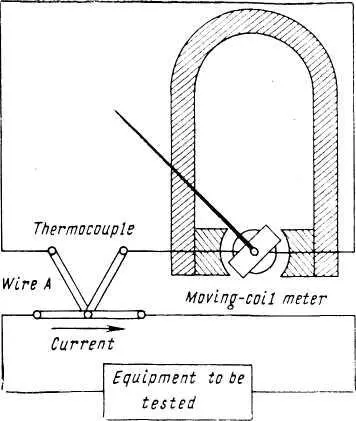 |
| Fig. 2. Arrangement of thermocouple meters |
b) Place a transparent film on the text and insert every fifth word (22) which is shaded on the film.
c) Fill in the blanks in such a way that it makes sense.
1. The convertion of applied current into deflection current is through a thermocouple.... a) actuated by two strips of dissimilar metal; b) actuated by heat generated at the junction; c) generated by input currents.
2. Thermocouple meters are used to... . a) measure voltage by the comparison method; b) operate through the electrostatic repulsion;
c) measure a wide range of either a-c or d-c currents.
3. Thermocouple meters are relatively. ... a) expensive; b) large;
c) cheap.
Now record your time and results 22—20 correctly inserted words+3 correct answers per 8 minutes get you an excellent mark.
20—18+2 per 9 ms — good. 18—17+2 per 10 ms — satisfactory.
Hometask: Ex, 31, 32.
Key
6 — aehn; 7 — cdgiklnprsuvxzb'c'; 8 — cdghjmp; 9—1, 4, 5; 11 — Iabiq, 1 lcegklmoprs; 12 — adfgj; 13—1. Этот механизм вышел из употребления в наши дни. 2. Почему вы не пользуетесь этим двигателем? 3. Эта конференция полезна всем нам. 4. Боюсь, что я здесь бесполезен. 5. Не стоит (не имеет смысла) пользоваться этим ваттметром. Кажется, он испортился. 17—2, 3; 22—Т. У него было мало времени, так же как и у других студентов. 2. В английском парламенте 2 палаты: палата общин и палата лордов. 3. У этих двигателей нет ничего общего. 4. Как вам нравится этот счетчик? — Знаете, в нём нет ничего особенного. 5. Ваша идея незаурядна, 29 — Frequency meter. 32 — 1Ь2сЗа.
Читать дальшеИнтервал:
Закладка:
Похожие книги на «Т.Ю.Кущ, М.С.ВоловникАнглийский язык для судовых электромехаников. ENGLISH FOR MARINE ELECTRICAL ENGINEERS. 1986»
Представляем Вашему вниманию похожие книги на «Т.Ю.Кущ, М.С.ВоловникАнглийский язык для судовых электромехаников. ENGLISH FOR MARINE ELECTRICAL ENGINEERS. 1986» списком для выбора. Мы отобрали схожую по названию и смыслу литературу в надежде предоставить читателям больше вариантов отыскать новые, интересные, ещё непрочитанные произведения.
Обсуждение, отзывы о книге «Т.Ю.Кущ, М.С.ВоловникАнглийский язык для судовых электромехаников. ENGLISH FOR MARINE ELECTRICAL ENGINEERS. 1986» и просто собственные мнения читателей. Оставьте ваши комментарии, напишите, что Вы думаете о произведении, его смысле или главных героях. Укажите что конкретно понравилось, а что нет, и почему Вы так считаете.





